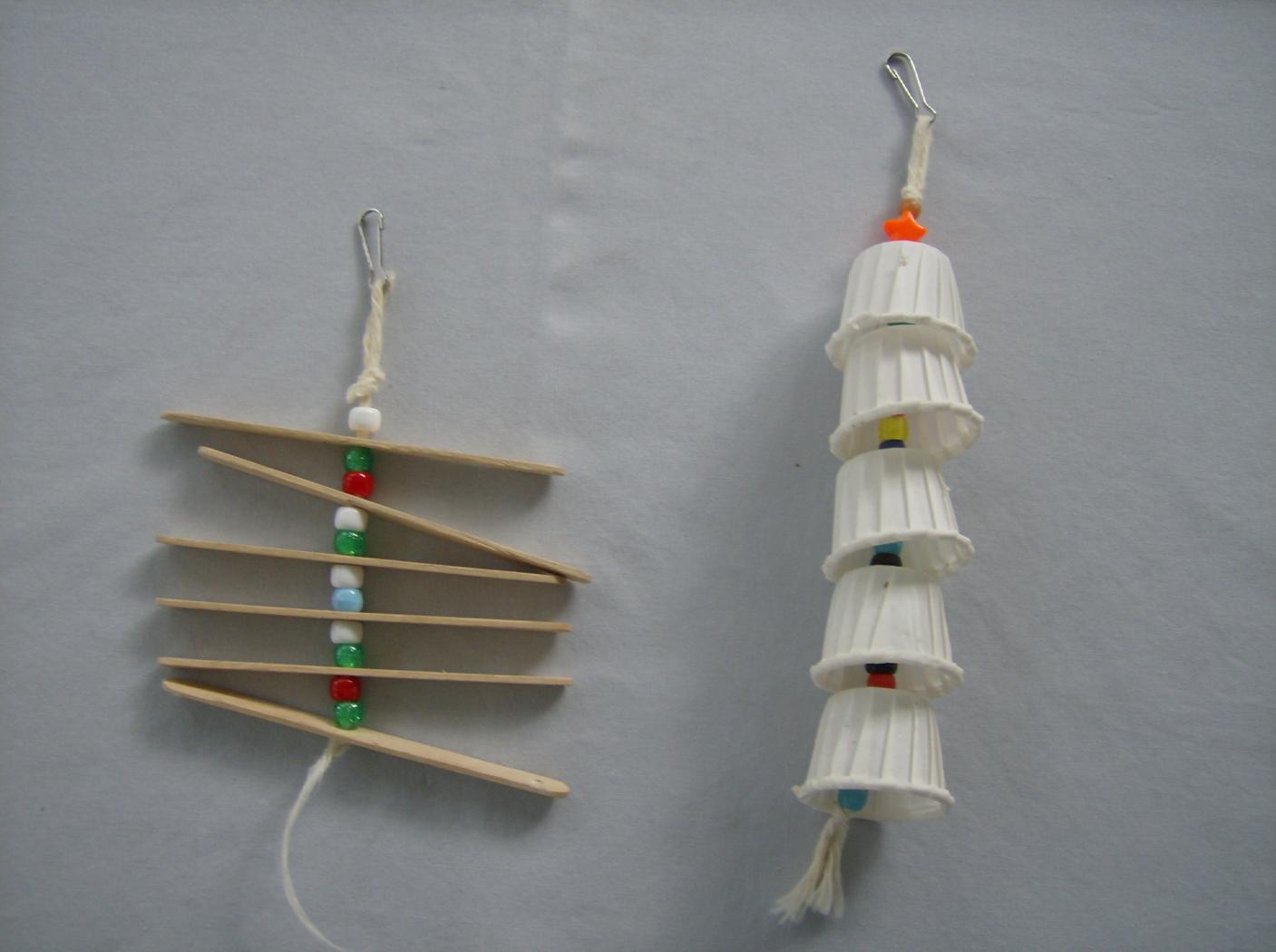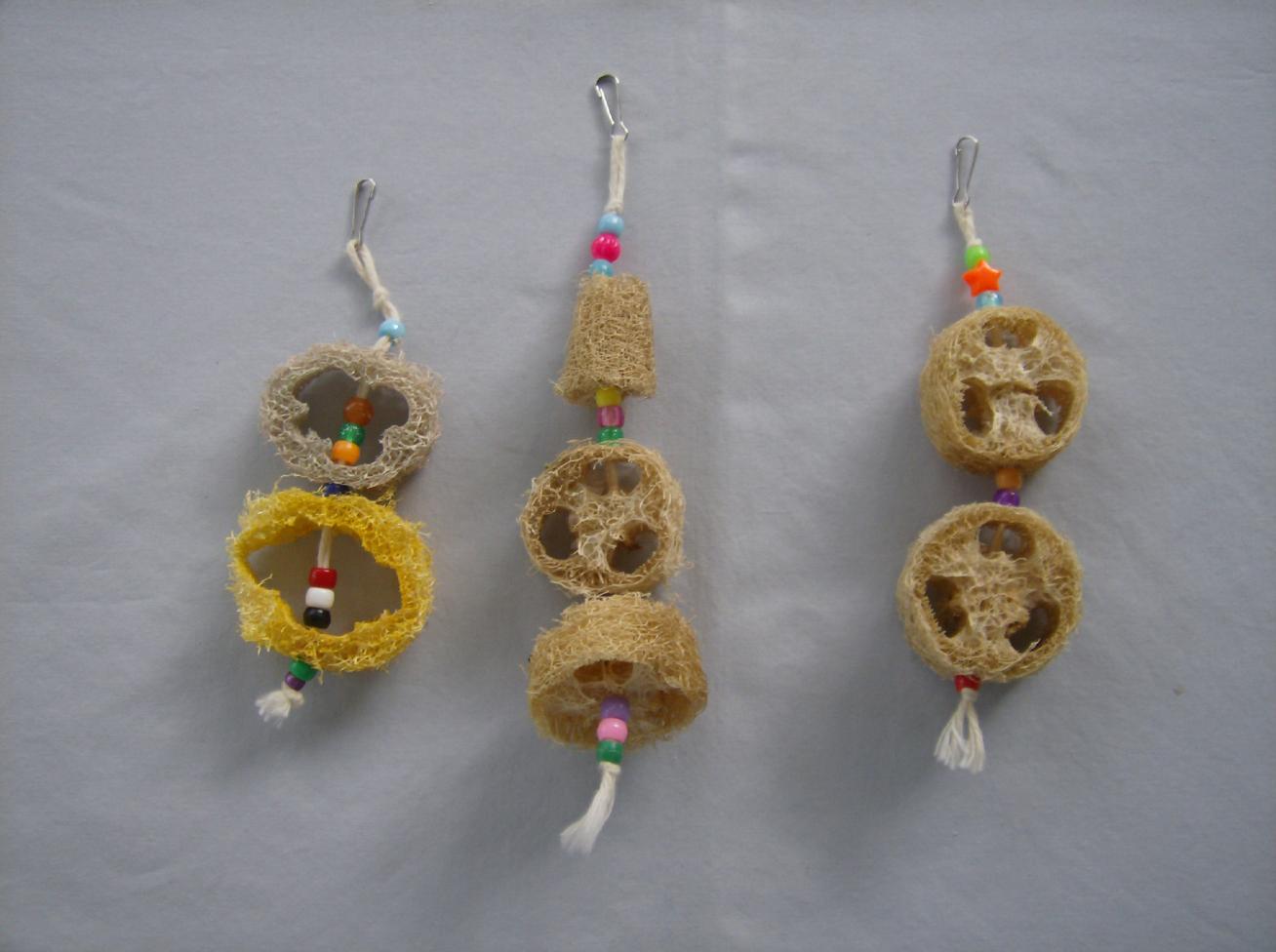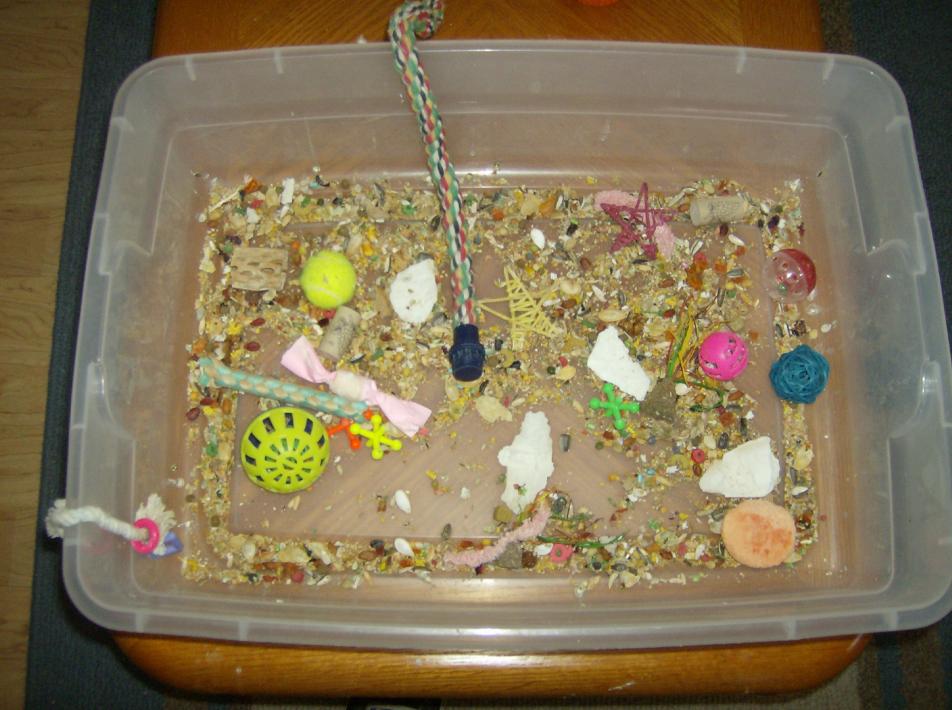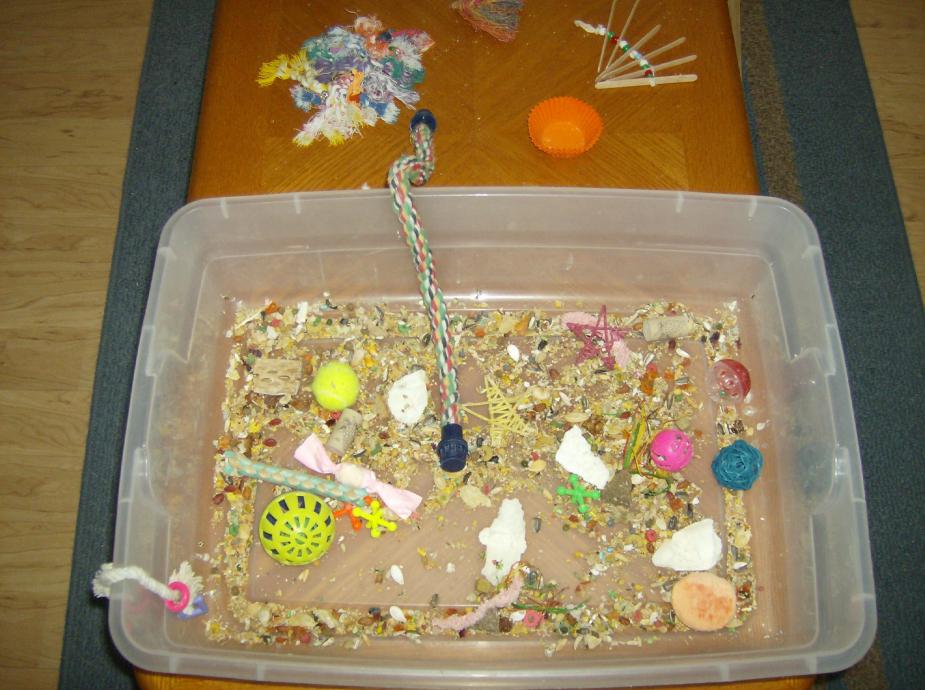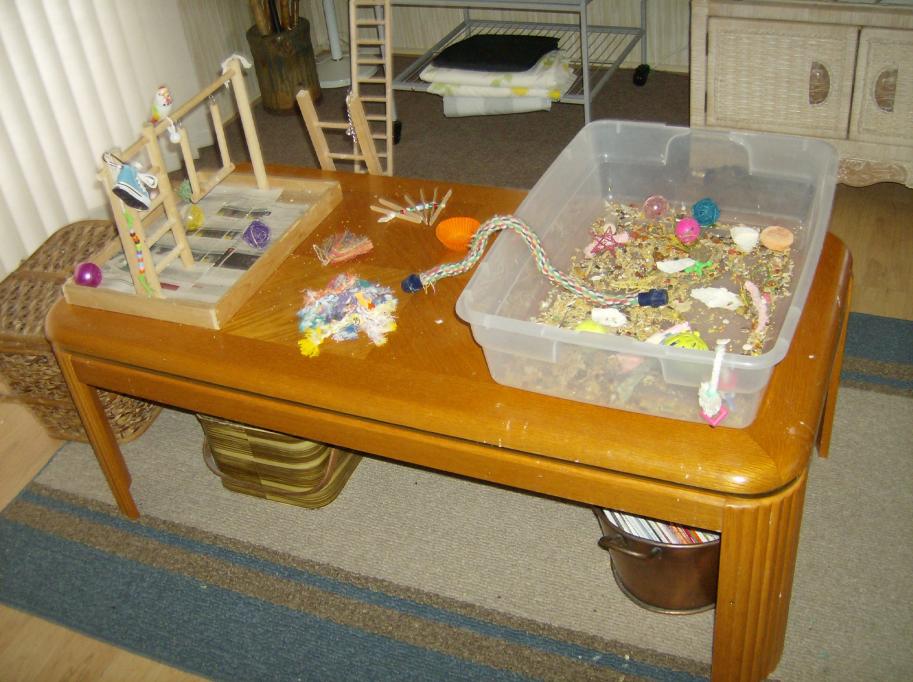NEW ADDRESS FOR MEMBERS GREYFORUMS.ORG
-
Posts
498 -
Joined
-
Last visited
Content Type
Profiles
Forums
Events
Gallery
Everything posted by BaileysPapa
-
I have been making bird toys for many years. Often people make intricate, involved things for their birds, which is great, but, doesn't always have to be. I make those kind, as well, but, I like to give them simple things to chew up and shred. One of our (my birds & myself) favorite materials is Natural Loofah. It is a gourd type plant, with the skin peeled off. The birds can chew it apart easily, and if ingested, it's only plant material, and will be digested. Though, it does not have much taste, and they just shred it, and drop the pieces. I buy the loofah on ebay, and cut them up myself. Very inexpensive. I also use undyed popsicle sticks from craft stores or dollar stores. And I also use wine corks. They, too, are natural, made from bark from tropical trees. And they, as well, have little taste, so the birds just chew them up and drop the pieces. But, if swallowed, the tiny pieces will be digested. Now, I will caution, as I always do, to monitor your pets activities, because, though these materials are natural and digestible, large pieces can produce blockages. However, in over 40 years of using these materials, with an uncountable amount of birds, there has never been a problem. I have donated many similar toys to various rescues & sanctuaries, again, without any issues. Here's photos of what I made this morning. The paper cups are condiment ketchup cups from Burger King. The manager is a bird lover, and for giving him a few of the toys, he lets me take as many as I want. It pays to network with fellow bird lovers! I had other pictures, but, cannot find them! Will update later.
-
Everything goes at their pace. Do not force yourself on him. If he's friendly, let him explore you and his new home. If not, take it slow, and let him guide your interaction. Remember that everything is new and possibly scary to him. You want to start off as calm, friendly, and unthreatening to him. That will build a good foundation for your lifetime together.
-
Is Pooka a rehomed bird? Often we do not know what rehomed birds know or have learned. I rescued a very old Double Headed Amazon many years ago. I had him about a week, and only heard him say a few things. A friend and I were sitting in another room from "George", and all of a sudden, we hear, "Help! Help! Let me outta here!" We knew, of course that it was George, and both of us burst out laughing. In the following weeks, I came to know that George cursed like a drunken sailor, and often made some very rude farting sounds, with laughter afterwards. I also had a rehomed Scarlet Macaw that made sexual innuendos to women. I had to remove him from the room when I had women friends over. And, lastly, I had a beautiful Hahn's Macaw that loved to make fart sounds when children were present, to hear, and join in with, their laughter. Needless to say, he was not involved with my educational work. Except as an example of what NOT to teach your bird.
-
The less reaction the noise gets, the sooner it will be replaced. Maybe give him a different new sound to concentrate on. Like a softer, more fun to say sound. I've often felt that the reason so many birds like to say "Poop", is because of how it feels to say it. I realize they don't use vocal chords like us. But, if you think of how we say "poop", it is a fun word to say. Maybe try something like gurgling, or bubbling sounds.
-
I like it as well, but, I'm curious why you haven't given her a name to call you. Were you seeing if she'd come up with an identity for you? You are the center of her world. Her guardian. Her flock leader. I feel that these intelligent creatures need a way of identifying each other. At least primary important flock members. I'm not criticizing, I'm just curious. You have done so many wonderful things with & for her. Please don't misunderstand me.
-
A difficult choice, indeed. I have experience with pluckers, and experience with collars. Sometimes they work, sometimes they increase the stress. If you trust your vet, I'd give it a try. Plucking is a difficult thing to stop, especially if it has become a habit. Good luck with this, and bless you for taking such good care of them.
-
Foraging things can be as simple, or as difficult, as we want to make. Some great ideas there! Thanks!
-
Many of us often say that they pick us, we don't pick them.
-
Sounds like Italian to me. Italiano, no? Anyone speak Italian? Is she wondering why the bird is making those sounds? My Grey makes the same whimpering grunts. Mine is a baby and doesn't know any other sounds yet.
-
If at first you don't succeed: changing (rehomed) diet
BaileysPapa replied to Inara's topic in Bird Food
Well done! Bless you for your patience and thoughtfulness! -
The way that I introduce new birds to my flock through the play box is to first get the new bird comfortable with the box by himself. Then, I put the new bird in the box, and bring the others to the box with the new bird already there. Also, you should bring the more aggressive birds, the more territorial birds, and the bigger birds, to the box after the other birds are already there. This makes it seem that the less aggressive, or smaller birds, are the "owner" of the space, and were there first. It doesn't always work, but, in flock dynamics, that gives the birds there first, a bit of an upper hand. And makes the later arrivals interlopers into the already occupied space. Again, not always. It depends on the birds' personalities. As with any toy or activity, your supervision, as flock leader, is the key to making this work.
-
Thoughts on "Should have more than one bird"
BaileysPapa replied to Lupine's topic in The GREY Lounge
Birds are like potato chips, you can't have just one! Seriously, it is up to you how many birds you want to have. Getting other birds for companions for your bird does not guarantee that they will get along. Also, things seem to increase exponentially with each new bird. There is more mess, more noise, more cage cleaning, more time needed for attention, etc. And, though I love Budgies, and in 45 years of keeping birds, I don't think there ever was a time that I did not have a few, their almost constant chatter and shrieks may be just what you don't want. I was always "that crazy man with all those birds". So, I've almost never had it any other way. I've never wanted it any other way. At the height of my rescue work, I used to clean some cages everyday. I got up early to feed & water before work. Birds, and their care, just became an integral part of my life. At one point, a fellow rescuer had to give up all of his birds. I took them in, and for a short while, I was caring for 43 birds! I had cages in every room, including the bathroom. Imagine the feeding, watering, and cleaning then! And the 43 didn't include my owls, poultry & pigeons. But, I AM "that crazy guy with all those birds". The point being, if you want something, you figure out how to make it work. -
This is a difficult problem that many of us with Multiple Bird Syndrome have. For over 45 years, I have had many birds at one time in my home. The only ones who've learned to stay off of others' cages, are a few that got bitten by the cages resident. And that does not always work, either. I've had some birds lose toes, and still go to other birds cages. What makes this more difficult is that she is used to flying to other cages. Perhaps your hysteria can help curb this by scaring her from doing it. Though, that has not worked for me. Good luck. If I think of anything, I'll get back to you.
-
Birds chew on the bars of their cage. And use their mouths to climb around. Rust is not good for them to ingest. Even sanding it down does not get rid of the rust. It will rust more in time. Unless you can have it sanded down in a place like an auto body shop, and then powder coated with the right paint, you should not use a rusty cage. If you are going to go ahead and paint it, get in touch with the paint manufacturer (or cage manufacturer) and find out what paint is not toxic to birds. Most of them are. For the amount of time, money, and work involved, you're better off buying a new cage. I'm a poor man, and a do it yourselfer, but I have thrown away many great, large cages, because I wouldn't take chances with my birds' lives.
-
Can hear COG shaking feathers/flapping a bit/itching noise
BaileysPapa replied to dannybrah92's topic in The GREY Lounge
I have a little trick that helps with bedtime. Our little bundles of feathered OCD like rituals. When I'm getting Bailey ready for bed, I sit with him in my lap, and scratch his head & neck. Of course, he's getting attention like that all day, but, for before bedtime, I hold him cupped against my hand, and cover his head with my other hand. We only sit like this at bedtime. After scratching him for a while, I start saying, "Bedtime" several times . He's starting to understand that after this, he is going to bed. At least, that's how I feel. We all know that everything is an uphill battle, but, little by little, he's getting it. -
Recently I posted about my Foraging Box/ Play Box, but could not add pictures. So, I've started this thread to show what I meant. It is a plastic storage box that you can buy in any Walmart, K Mart, or many other stores. I used the "under the bed" size. I am using an old rope perch as a ladder for the fids to climb into & out of it. I put all kinds of foot toys, shredding things, wicker balls, bamboo finger traps, plastic children's jacks, and anything else I think the fids would like. I also sprinkle dried fruit, Nutri-Berries, various seeds, pellets, etc. I just add a few each day. Also, everyday I clean any poops out of it. But, I only clean the box out every 10 days or so. This allows a build up of material for them to forage through. Then, I empty the seedhulls, etc. in the garbage, wash any toys that need washing. And wash the entire box with hot soapy water. After wiping it out, and letting it dry, we start all over again. This box is used by all of my birds, from my tiny Parrotlet, to my big, beautiful Grey. Each bird has favored things, and I make sure that there is always a good choice for each of them. This is also a good place to introduce new toys, new foods, and new friends. It is not any one birds' cage, so several of them get along in here, like a communal feeding area. Of course, they don't all get along, all the time. So, like any toy or activity, your supervision is the key to making this work.
-
I love that..."big boy" feathers! Good job!
-
I've signed also! Someone should flash strobe lights in those arrogant & abusive bastards eyes! I'll do it for free. Saves $50.00!
-
I love the various voices that they use. He certainly knows kissing sounds. I know I'd kiss him a lot. Mine is still too young, but, tries all kinds of sounds.
-
Just like protein, fats are necessary for life & growth. Moderation is the key. When my wife read about fatty liver disease, she immediately cut all the sunflower seeds out of her parrotlets diet. He seemed fine. At one point, I realized that he was picking a lot of dead skin off of his legs & feet, plus his feathers looked like a constant molt. We took him to the vet, concerned about possible mites. She said, no mites, but his skin is very dry on his feet, legs & cere. She prescribed a bit of mineral oil on the dry areas. In thinking about this guys skin and feathers, I remembered that my wife is a diet psycho, and often cuts out any and all fat. Resulting in dry skin & hair. So, we put him back on a few sunflower seeds, and some other seed treats. His feathers look great, his feet & legs are no longer dry, and he does not pick at them. Every living animal needs a balance of fats, carbohydrates & protein. Everything in moderation.
-
How great is that! What good relationship you both have. And you sound like a very good parront.
-
A long time ago, I was at a seminar, and someone told me about what we might call a foraging game. Do you always put the seed bowl in the same place? the water bowl? pellets? Well, move them around! Many of the larger cages have stainless steel bowls in each corner. Well, instead of putting everything in the same place, mix it up for them. Helps with accepting change. Makes looking for the pellets more fun, and really is a basic foraging situation. Change bowls around often. I have done this with several birds. The smaller cages, for the smaller birds, have 2 or 3 cups in front. Not much variety, but switch them around anyway. I also alternate places to hang water bottles, millet sprays, and mineral blocks. To some birds, this becomes a fun guessing game. They look for their favorite items, and climb around, investigating things. If for some reason, your bird is stressed out by this, of course, discontinue doing so.
-
Inheriting my Grandmother's Baby
BaileysPapa replied to Reno912's topic in Welcome & Introduction Room
Since this a total lifestyle change for Baby, I'd introduce the new cage right away. Like said, a few familiar toys will ease some anxiety. But, since so much is changing (her guardian, her home environment, her routines) at one time, I'd throw a new cage in the mix to make the transition complete in one action. And she'll adjust to all the changes she has to go through at the same time. She sounds like a relatively well adjusting, social, happy bird, and I think she'll adjust just fine. -
Happy Anniversary to you, Happy Anniversary to you, Happy Anniversary, Luvparrots, Happy Anniversary to you!
-
Foraging Fun is great for your parrot's mind and health.
BaileysPapa replied to lovethatgrey's topic in Health Room
Some great ideas! I have a "foraging box" that I keep on my table in the livingroom. It is a plastic storage container found in so many stores like Walmart, Big Lots, K Mart, etc. I put foot toys, treats, seeds, pellets, shredding things, wicker things, various balls, etc. And add things all the time. Once in a while, I empty the seedhulls, shredded paper, etc. Clean the toys, etc. Wash out the container. And start all over again. All my birds spend time in there, poking around, finding favored treats and toys, and just enjoying themselves. I tried to include a picture, but, I'm almost computer illiterate, and couldn't make it happen.


